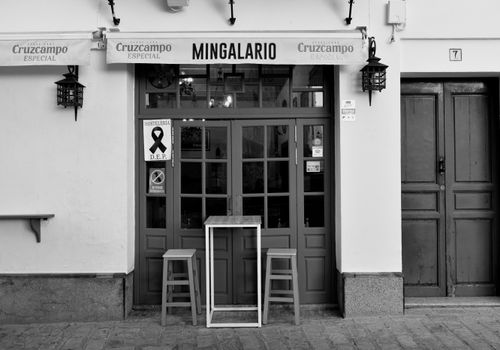English version below
Siesta andaluza
(…)
La compasión confunde
(nos hace odiar y amar al mismo tiempo)
desata nuestras culpas
adensa entre las manos la moneda
con la que consolamos la impotencia
y nos convierte en frágiles
seres sentimentales
tan oscuros a veces a las puertas del sueño
e incapaces de ir firmes y rotundos
como esos otros
los imperturbables.
Piedad Bonett
Camino por calles y callejuelas con pendientes. Observo la presencia replicada de lazos negros en carteles de luto, como gritos, en algunas de sus fachadas comerciales. Voces potenciadas por la ausencia de aromas, sabores, imágenes, sonidos, costumbres y ritmos, me invitan a indagar en la expresión gráfica, pública y deliberada, de las consecuencias tangibles de la crisis económica que sufre el sector de la hostelería, a causa de la pandemia de coronavirus. Intercaladas a modo de flashes con la realidad, veo pasar en mi mente una sucesión de imágenes en blanco y negro de frentes de comercios cerrados. En unas hay simetrías y grafitis, en otras asimetrías y carteles iguales. Me detengo en las tipologías características de las ciudades que ambas habitan. Mi punto personal de contingencia es, muy pudorosamente, la memorable serie Siesta argentina, acerca de la crisis del 2001 en Buenos Aires, de Facundo de Zuviría.
Durante la actual segunda ola de coronavirus en España, el toque de queda y las consecuentes restricciones, condicionan nuevamente el horario de apertura y cierre de los negocios y profundizan la crisis económica del sector de la hostelería y los pequeños comercios. La limitación horaria es -“la siesta”- tópico no pocas veces asociado a Andalucía, la región más cálida de toda Europa. En verano, cuando se siente que el calor emana del mismísimo magma de la Tierra, recuerdo a Juan Rulfo en la voz del personaje de Abundio Martínez en Pedro Páramo que, para dimensionar el intenso calor de su Comala, no escatima en afirmar: “Con decirle que muchos de los que allí se mueren al llegar al infierno regresan por su cobija”. Esa pausa, despojada de su necesidad, de su mística y de sus detractores deviene, en la eventualidad de la prohibición, en el sueño inducido de un paciente en estado crítico.
Las fotografías resultan una evocación metafórica de la muerte. Intentan mostrar en su manifestación la analogía (si es que fuese posible), entre las personas víctimas de la covid-19 y la realidad del comercio local, generada por las medidas adoptadas para enfrentarla. El punto de fatalidad, la paradoja de la muerte para evitar la muerte.
A pesar de sí misma Siesta andaluza es desde su concepción optimista, más bien por la imposibilidad de ser otra cosa, que por la realidad misma. Aguarda en modo recursivo los regresos del infierno: “¡A por sus cobijas!”. O tal vez, el exceso de realidad encuentre antídoto en el lirismo de Alfonso Grosso: "Los caballos andaluces se burlan, de los que al norte de Despeñaperros no creen en los centauros"
15 de Diciembre de 2020, Carmona
Publicada en la Revista FotoargentA, enero 2021
Serie del Día FotoRevista, 1 de febrero de 2021
Andalusian Siesta
(…)
Compassion confuses
(makes us hate and love at the same time)
unleashes our guilt
it tightens between our hands the coin
with which we console our impotence
and turns us into fragile
sentimental beings
so dark at times at the gates of sleep
and incapable of going firm and resolute
as those others
the imperturbable ones.
Piedad Bonett
I walk through streets and alleys with slopes. I observe the replicated presence of black ribbons on mourning posters, like screams, on some of its commercial facades. Voices enhanced by the absence of aromas, flavors, images, sounds, customs and rhythms, invite me to inquire into the graphic expression, public and deliberate, of the tangible consequences of the economic crisis suffered by the hospitality sector, due to the coronavirus pandemic. Interspersed as flashes with reality, I see in my mind a succession of black and white images of closed store fronts. In some there are symmetries and graffiti, in others asymmetries and identical signs. I dwell on the characteristic typologies of the cities they both inhabit. My personal point of contingency is, very modestly, the memorable series Siesta argentina, about the 2001 crisis in Buenos Aires, by Facundo de Zuviría.
During the current second wave of coronavirus in Spain, the curfew and the consequent restrictions once again condition the opening and closing hours of businesses and deepen the economic crisis of the hospitality sector and small businesses. The time restriction is - "la siesta"- a cliché often associated with Andalusia, the warmest region in Europe. In summer, when you feel that the heat emanates from the very magma of the Earth, I remember Juan Rulfo in the voice of Abundio Martinez's character in Pedro Paramo who, to measure the intense heat of his Comala, does not skimp on stating: "By telling him that many of those who die there when they get to hell return for their blanket". That pause, stripped of its necessity, its mystique and its detractors, becomes, in the eventuality of prohibition, the induced sleep of a patient in critical condition.
The photographs are a metaphorical evocation of death. They try to show in their manifestation the analogy (if it were possible), between the victims of covid-19 and the reality of the local commerce, generated by the measures adopted to face it. The point of fatality, the paradox of death to avoid death.
In spite of itself, Siesta andaluza is from its conception optimistic, more because of the impossibility of being something else, than because of the reality itself. It awaits in recursive mode the returns of hell: "Let's get your blankets! Or perhaps, the excess of reality finds an antidote in the lyricism of Alfonso Grosso: "The Andalusian horses mock those who north of Despeñaperros do not believe in centaurs."
December 15, 2020, Carmona
Published in FotoargentA Magazine, January 2021
FotoRevista Series of the Day, February 1, 2021













